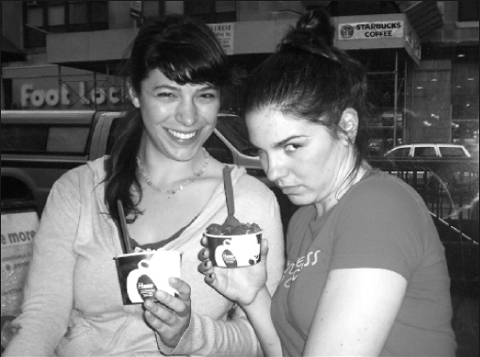By Joy Wiltermuth
Rivalry? What rivalry?
Two hip frozen-yogurt companies share a clientele and an unloved corner near Union Square. Red Mango opened its mellow, chocolate-and-red-colored store at 63 W. 14th St. last December. Three months later, Pinkberry plopped down a bright-neon-green-and-pink shop around the corner, at 523 Sixth Ave. Both offer nonfat, tangy options of original and green tea-flavored yogurts. Fruit and berry toppings abound, along with nuts, chocolate bits and cereal flakes. But, as franchises continue to pop up in close proximity, customer loyalties have begun to divide between the two local yogurteries.
Abbi Hawk and Kate Pistone recently had a bad day at work at the Chelsea Brewing Company and, despite a dreary, rain-soaked afternoon, ended up at Red Mango. The brewery restaurant’s dumbwaiter was broken and they ran up and down the stairs throughout their shift.
“I loved Pinkberry. I still do, but my friend told me I would like this better,” Pistone said. Nestled in a cozy, window front seat at Red Mango, they laughed and chatted over tart, original-flavored yogurt treats. Pistone was eating a mix of raspberry, blueberry and strawberry, while Hawk’s was a mochi-and-dark chocolate mix. Hawk said she preferred Red Mango yogurt’s texture. “It’s more like a creamy custard,” she said.
Lurking within view, Pinkberry exploded with electronic music filling its translucent space. Steffy Fonda, together with two giggly friends from Indonesia, sat next to a window.
“Usually it tastes good,” she said. “But today the mango is not good.” They were divided in loyalties to certain fruit toppings, and one liked green tea, while the others preferred the original, as a yogurt base. It was their fourth visit to the raved-about chain. None of them had heard of Red Mango, but they presumed Pinkberry’s brand was probably better.
These three friends are still sticking with Pinkberry.
“There definitely is one,” said Daniel J. Kim, Red Mango C.E.O and president, when asked about the rivalry. He said the conflict’s nature was twofold — over the stores’ products and the chains’ expansions. Red Mango first nurtured the health-treat craze in South Korea. He said Pinkberry ran with the innovation in the States.
“In 2005, Pinkberry basically took the formula and opened in West Hollywood,” Kim said.
Red Mango started in 2002 as the brainchild of Kim, then 31, a University of California-Berkeley graduate. “It’s kind of in my blood,” Kim said, and described the transition to entrepreneur from finance as natural. “I was always a health nut,” he said.
Executives of the “Red Is Real” company boast their product’s healthfulness, highlighting it as the first to be awarded the National Yogurt Association Seal for live and active yogurt cultures. Kim said the chain next will go kosher, in order to satisfy the dietary restrictions of a greater clientele.
“Pinkberry is and always was frozen yogurt and has always contained live and active cultures,” said Heather Wilson, Pinkberry’s public relations person. Last year, the company found itself in court over its “swirly goodness” and frozen yogurt claims. When asked about the yogurt-culture controversy, Wilson said, “The issue you are referring to stemmed from a California-specific law that required frozen yogurt to be mixed off-site at a licensed dairy and not in stores. Pinkberry now mixes its yogurt in a dairy, as required by California law,” she noted. “In New York, frozen yogurt can be mixed in stores — and Pinkberry mixes its yogurt in stores there.” The dispute over yogurt culture criteria has since been remedied and Pinkberry also carries the N.Y.A. seal.
“What sets Pinkberry apart is that it is an experience for all the senses — from its unique tangy taste, to the design of the stores, to the upbeat music to its employees,” said spokesperson Wilson. “It provides people with an affordable luxury.”
Last year, the chains tried to freeze each other out on Bleecker St., where Pinkberry opened first and Red Mango followed. Their doors are on opposite sides of the narrow city street. They have a similar close-proximity yogurt showdown going on in Flushing, Queens. Pinkberry aggressively launched 13 stores in the New York City market, while Red Mango so far has four in Manhattan and one in Queens.
“We co-exist in New York and L.A.,” Kim said. However, Red Mango has only half as many stores as Pinkberry in the two cities.
Meanwhile, both brands have become wildly popular among the trendy, health-conscious yo-set. Unlike previous frozen-yogurt chains, Red Mango and Pinkberry were not conceived as substitutes to ice cream. The two stores’ products would not be mistaken for a cream-laden dessert. Instead, patrons called the frozen yogurt refreshing, light and something that “felt good for you.”
Clearly, in this yogurt cold war, the customers are winning out.
































